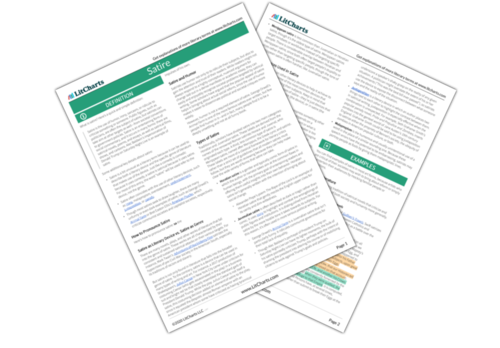Satire
Satire is a genre of literature, art, or performance that employs humor, irony, exaggeration, or ridicule to expose and criticize human vices, follies, or societal shortcomings. It often targets individuals, institutions, or broader cultural phenomena with the intent of provoking change or encouraging reflection. Satire can take various forms, including written works, visual media, or theatrical productions, and it frequently relies on wit and sarcasm to convey its message. By highlighting absurdities or contradictions, satire serves as both entertainment and social commentary.
Satire is a form of expression that uses humor, irony, or exaggeration to critique or mock individuals, institutions, or societal norms. Here’s a brief and straightforward explanation:
Satire employs humor, irony, sarcasm, or mockery to expose and critique flaws in individuals or institutions. While public figures like politicians are frequent targets, satirists may also direct their criticism toward broader societal issues. Satire also takes aim at various targets—ranging from social norms to political decisions. This humorous style of critique appears in diverse formats, including satirical books, poetry, articles, movies, TV programs, and animations. A notable instance is Alec Baldwin’s portrayal of Donald Trump on *Saturday Night Live*, which embodies satire.
Satire employs wit, irony, mockery, or exaggeration to expose and critique flaws in individuals or institutions. While public figures like politicians are frequent targets, satirists may also direct their criticism toward broader societal issues. Satire also takes aim at various other objectives—ranging from social norms to political decisions. As a humorous yet insightful critique of society, it appears in diverse formats, including satirical books, poetry, and articles, alongside satirical movies, television programs, and animations. A notable instance is Alec Baldwin’s portrayal of Donald Trump on *Saturday Night Live*, which exemplifies satire.
- Satire stands out among literary terms due to its dual nature, functioning as both a stylistic technique and a distinct genre. Unlike most concepts in literature, it uniquely bridges the gap between a narrative tool and a standalone form of expression. This versatility allows satire to critique societal norms, human behavior, or institutions through humor, irony, or exaggeration, whether embedded within a larger work or as the foundation of an entire piece. Its ability to serve multiple purposes makes it a powerful and flexible element in writing.andThe particular literary genre that employs this technique. Just as a comedy derives its humor from comedic elements, a satire gains its sharpness through satirical content. Throughout much of this discussion, the term “satire” will denote the technique itself rather than the genre.
- Satire frequently aligns with the employment of additional literary techniques, including irony,malapropism, overstatementsubtlety, irony, or mockery.
- Though satire often aims to provoke laughter, numerous instances, like George Orwell’s works, are devoid of humor or even carry a somber tone.The farm where animals live and work togetheror Bret Easton Ellis’s*American Psycho* follows the life of Patrick Bateman, a wealthy investment banker in Manhattan who leads a double life. By day, he embodies the image of success and charm, but by night, he indulges in violent, psychopathic tendencies. The story critiques the excesses of 1980s Wall Street culture, exploring themes of materialism, identity, and moral decay. Bateman’s unreliable narration blurs the line between reality and delusion, leaving his crimes ambiguous. The novel is a dark satire of yuppie culture and the superficiality of modern society., which critique both communist and capitalist societies in their respective contexts.
Mastering the Pronunciation of Satire
Satire as a Literary Device Compared to Satire as a Genre
Many novels, plays, and literary works belong to the satire genre. These pieces are defined by their relentless and prolonged satirical critiques of their chosen subjects. A notable example is Mark Twain’sThe Adventures of Huckleberry Finnmocks the hypocrisy of pre-Civil-War Southern society in the United States, particularly its racist customs and reliance on enslaved labor.
But satire does not serveonlySatire is not confined to literature alone; it is a versatile tool employed across various forms of writing and artistic expression. For example, a 2017 staging of Shakespeare’s works demonstrates this adaptability.Julius Caesara production in New York City faced backlash for dressing Caesar (who is assassinated in the play) in a business suit and a vivid red tie that bore a striking resemblance to the typical attire of President Donald Trump. Despite the playJulius Caesaris not inherently satirical, this wardrobe choice introduced anelementThe use of satire in the play draws a parallel between the authoritarian near-Roman-emperor and a U.S. president accused by some of displaying similar dictatorial tendencies.
Satire and Comedy
Satirists employ humor not just to mock their targets but also to capture their audience’s interest and build rapport. Readers may not engage with complex, abstract arguments for change presented in lengthy manifestos or scholarly articles, yet they readily and delightfully identify societal issues highlighted through satire. Certain academics contend that satire’s widespread attraction contributes to tangible social progress, as its comedic approach allows political and cultural criticisms to reach a broader audience more effectively.
However, satire does not necessarily rely on humor. George Orwell’sAnimal Farmstands as one of the most renowned satires in literature, yet its humor eludes most readers—indeed, many consider it profoundly disturbing and far from amusing.
Forms of Satirical Expression
Historically, academics have classified satire into two primary types: Horatian and Juvenalian satire. These labels originate from the titles of the famous Roman satirists. Horace and Juvenal, who pioneered their respective styles. A third, less frequently encountered form of satire isMenippean Satire, derived from Menippus, the Greek cynic and satirist. These classifications serve as a traditional structure for literary analysis rather than rigid rules that contemporary satires must adhere to, yet they remain valuable to examine as they highlight the diverse range of forms satire can embody.
-
Horatian satire Horatian satire is a lighter, often humorous style of critique that targets universal human imperfections. Its main purpose is to amuse the audience while providing them with reflective observations about their own actions. Unlike more aggressive forms of satire, Horatian satire does not primarily aim to drive societal reform.
- Alexander Pope’s poetic workThe Theft of the LockThe piece exemplifies Horatian satire, lightly ridiculing the English aristocracy for its foolishness and self-absorption.
-
Juvenalian satire employs sharp, biting humor to critique societal vices and human folly, often with a tone of scorn or moral indignation. Unlike its more light-hearted counterpart, Horatian satire, it delivers harsh, unrelenting criticism aimed at provoking change or exposing corruption. This form of satire is marked by its pessimistic outlook and willingness to confront uncomfortable truths, making it a powerful tool for social and political commentary.is frequently characterized as somber or bleak rather than humorous. It employs irony to expose and challenge the misconduct of prominent individuals and organizations. Unlike Horatian satire, it adopts a sharper, more critical stance toward its targets. As a result, it is commonly utilized in weightier political discourse.
- George Orwell’s *1984* presents a dystopian society under the oppressive rule of the Party, led by Big Brother. The novel explores themes of surveillance, propaganda, and the manipulation of truth through the experiences of Winston Smith, a low-ranking member of the Party. As Winston rebels against the regime, he grapples with the consequences of thoughtcrime and the erasure of individual freedom. The work serves as a cautionary tale about totalitarianism and the dangers of unchecked government power.The farm where animals live and work togetherThe work serves as a Juvenalian satire devoid of much humor, mocking communist regimes for their complete absence of equality.
- Though Alec Baldwin’s depiction of President Trump on Saturday Night Live was widely praised, it also sparked controversy among some viewers who felt the impersonation was overly exaggerated. His performance, while humorous to many, drew criticism for its perceived lack of nuance and fairness. Despite the mixed reactions, Baldwin’s recurring role became one of the show’s most talked-about segments during that period.Saturday Night LiveWhile his satire may include lighter touches, the majority of it sharply targets Trump, likely aiming to push the president toward changing his direction or to inspire the public to oppose Trump’s objectives and policies.
- Menippean satire employs a blend of humor, irony, and parody to critique societal norms, often through a mix of prose and verse. It targets pretentiousness and intellectual arrogance, using chaotic structure and fantastical elements to undermine its subjects. Unlike other satirical forms, it emphasizes philosophical discourse while maintaining a playful, absurd tone.Menippean satire is the oldest form of satire, though it is less prevalent than Juvenalian or Horatian satire. Unlike satires that focus on individuals, Menippean satire critiques attitudes or broader perspectives. While it shares similarities with Horatian satire—both frequently address human folly or flaws rather than singling out particular figures—Menippean satire tends to adopt a sharper tone, more akin to Juvenalian satire.
- Alexander Pope’s poetic workThe Theft of the LockThe piece exemplifies Horatian satire, lightly poking fun at the English aristocracy for its foolishness and self-absorption.
- George Orwell’s *1984* presents a dystopian society where the government, led by the Party and its figurehead Big Brother, exercises absolute control over citizens. The protagonist, Winston Smith, works at the Ministry of Truth, altering historical records to align with the Party’s ever-changing narrative. Through constant surveillance, propaganda, and the manipulation of language via Newspeak, the Party erases individuality and independent thought. The novel explores themes of totalitarianism, psychological manipulation, and the suppression of dissent, serving as a cautionary tale about the dangers of unchecked power and the erosion of truth.“Animal Farm” is a novella by George Orwell that allegorically depicts the events leading up to the Russian Revolution of 1917 and the early years of the Soviet Union. The story unfolds on a farm where the animals, led by the pigs, overthrow their human owner in pursuit of a fairer society. Over time, the pigs become increasingly corrupt, betraying the principles of equality they once championed. Through this narrative, Orwell critiques the rise of totalitarianism and the betrayal of revolutionary ideals. The work remains a powerful commentary on power, corruption, and political manipulation.is a Juvenalian satire devoid of humor, mocking communist regimes for their complete absence of equality.
- Though Alec Baldwin’s depiction of President Trump onSaturday Night Live remains a late-night comedy staple, blending live sketches, musical performances, and celebrity guest appearances. The show has been a cultural touchstone since its debut, known for launching careers and delivering sharp satire. Its format, combining humor and topical commentary, continues to resonate with audiences week after week.While it may include moments of levity, his satire primarily targets Trump with sharp criticism, likely aiming to pressure the president into changing his direction or to inspire opposition against Trump’s objectives and policies.
Satirical Techniques Employed in Literature
Satire frequently relies on other forms of expression to convey its message effectively.literary techniquesto enhance its impact. The following outlines some of the most frequently used techniques satirists utilize to ridicule their targets. Note that these methods are not exclusive.typesof satire—these are simply tools frequently employedas part ofemploying satire (the technique), orin satire (the art form).
- Words that convey a meaning opposite to their literal interpretation.involves employing language to convey a meaning opposite to its literal interpretation. This form of irony relies on a gap between the words spoken and the intended or actual truth—making it a favored tool for satirists to imply that a speaker is either too ignorant to grasp reality or deliberately deceitful. Picture a public official assuring a crowd, “Everything is under control!” moments after a dam collapsed in front of them. Such a scenario would serve as sharp satire, highlighting a government’s indifferent reaction to a crisis.
- A chronological inconsistencyAn anachronism refers to a person or object that exists outside the time frame in which a story or narrative takes place. Writers, particularly satirists, may employ anachronism to highlight how disconnected a subject is from their surroundings. For instance, if a modern-day politician assured a 21st-century audience that steamboats would save them, the audience would recognize this as a sign of the official’s ineptitude or lack of awareness in addressing the issue.
- ParodyParody mimics a literary style to create humor. Writers employing satire utilize parody to critique established literary norms and rhetorical traditions, frequently amplifying the defining traits of a genre to the point of absurdity. An illustration of this can be seen in the opening of Miguel de Cervantes’ renowned work,,Cervantes mocks the grandiose literary trends of his era in Spain by crafting exaggerated versions of the ornate poems frequently referenced by other authors in their prologues. While these writers used such verses to dazzle audiences and assert credibility, Cervantes’ satirical take exposes their pretentiousness and absurdity.
- UnderstatementUnderstatement involves minimizing the scale, importance, or value of something. Satirists favor this technique because, similar to irony, it effectively exposes a speaker as dishonest or misguided. When a leader downplays the consequences of their actions (e.g., “Perhaps initiating an unwinnable conflict wasn’t ideal”), it highlights the incompetence or lack of judgment often found in those who hold authority.
- OverstatementHyperbole involves amplifying the scale, importance, or merit of something. This technique can also highlight a speaker’s tenuous understanding of the actual circumstances. For instance, a leader may inflate their accomplishments (“This was the greatest legislation ever enacted”), prompting satirists to employ the device to reveal the gap between claims and truth.
- Juxtaposition is a literary technique where an author positions two elements side by side to emphasize their differences. In satire, this method works particularly well when the pairing is surprising. A notable example is Seth Grahame-Smith’s widely known parody novel.Pride and Prejudice and Zombies,Grahame-Smith introduces zombies into the refined setting of Jane Austen’s 19th-century England. One might argue that he employs juxtaposition to mock either the decorum of Bennet’s society, the pervasive presence of zombies in American pop culture, or simultaneously both.
- MalapropismMalapropism is the amusing and often accidental substitution of a word with another that sounds alike. Since these verbal slip-ups can lead to awkward situations, comedians and writers sometimes depict characters as unintelligent by having them deliver lines filled with malapropisms.
Examples of Satire
Satire appears across various art forms, as creators seeking to critique societal norms often aim to inspire change or amuse their viewers by humorously targeting well-known figures or establishments.
The Use of Satire in Literary Works
Satirical novels have a rich history of mocking and critiquing various facets of society, as well as human nature as a whole.
Jonathan Swift’s *Gulliver’s Travels* critiques human nature and societal flaws through satire. The novel follows Lemuel Gulliver as he voyages to fantastical lands, each exposing different human follies. From the petty conflicts of Lilliput to the irrational scholars of Laputa, Swift highlights hypocrisy, pride, and corruption. His sharp wit and exaggerated scenarios reveal the absurdities of politics, science, and morality in 18th-century Europe. By contrasting Gulliver’s experiences with reality, Swift challenges readers to reflect on their own shortcomings and the flaws of civilization.Gulliver’s Travels
In this illustration from Chapter Four ofGulliver’s Travels recounts the extraordinary voyages of Lemuel Gulliver, a ship’s surgeon who encounters fantastical lands and peculiar civilizations. His adventures take him to Lilliput, where the inhabitants are minuscule, and Brobdingnag, a realm of giants. Later, he visits the floating island of Laputa and the rational horses known as Houyhnhnms, contrasting sharply with the brutish Yahoos. Through these journeys, Swift critiques human nature, society, and politics with biting satire.Swift critiques the long-standing tensions between Catholics and Protestants in England, portraying their discord as a dispute over the proper method of consuming eggs.
The incident originated from the following circumstance. There is universal agreement that the original method of cracking Eggs before consumption was at the broader End. However, the grandfather of his current Majesty, during his youth, once attempted to eat an Egg by following this age-old custom. In doing so, he accidentally injured one of his fingers.The Emperor’s father then issued a decree, imposing severe penalties on any subject who failed to crack the smaller end of their eggs.
The People deeply opposed this Law, and historical records indicate it sparked six separate Rebellions as a result.t; where one Emperor met his demise, and another was stripped of his throne.The rulers of Blefuscu persistently incited these civil disturbances; andAfter being subdued, the Exiles invariably sought sanctuary within that Empire.It is estimated that over eleven thousand individuals have, at various points, chosen to face execution rather than comply with the demand to crack their Eggs at the narrower extremity.
The incident originated under these circumstances. There is universal agreement that the original method of cracking eggs before consumption was at the broader extremity. However, the reigning monarch’s grandfather, during his youth, once attempted to eat an egg by following this age-old custom and accidentally injured his finger in the process.The Emperor’s father then issued a decree, ordering all his subjects, under severe penalties, to crack the smaller end of their eggs.
The populace deeply opposed this Law, and historical records indicate it sparked six separate uprisings as a result.t; where one Emperor met his demise, and another was stripped of his throne.These civil disturbances were continually stirred up by the rulers of Blefuscu; andAfter being subdued, the Exiles invariably sought sanctuary within that Empire.It is estimated that over eleven thousand individuals have, at various points, chosen to face execution rather than compromise by cracking their Eggs at the smaller End.
While the conflict between the two groups of egg-eaters is undeniably absurd—participants would sooner perish than consume their eggs the “wrong” way—Swift is, in fact, mocking the religious disputes that have significantly influenced English politics for centuries by portraying these disagreements as trivial and capricious. Through this, Swift underscores his satirical critique of England’s religious strife.allusionthe religious uprisings that led to the death of King Charles I in 1625 and forced his successor, James II, to escape to France. ByjuxtaposingSwift ridicules the intensity of the prolonged conflict by highlighting the king’s exaggerated flight, spurred by an insignificant statute.
Satire in Alexander Pope’s works serves as a sharp critique of societal flaws, blending wit with moral insight. His clever use of irony and exaggeration exposes human follies, particularly in *The Rape of the Lock* and *The Dunciad*. Through mock-heroic elements and biting humor, Pope highlights the vanity and triviality of his contemporaries, while also addressing broader cultural decay. His satirical approach remains influential, showcasing the power of literature to challenge and reflect societal norms.The Violation of the Lock
In the Third Canto of *The Faerie Queene*, Edmund Spenser continues the allegorical narrative, weaving intricate themes of virtue and chivalry. The canto follows the adventures of Britomart, a knight embodying chastity, as she navigates trials that test her resolve. Spenser’s rich imagery and symbolic storytelling highlight the moral and spiritual challenges faced by his characters, reinforcing the poem’s overarching exploration of human ideals. The interplay between fantasy and reality remains central, immersing readers in a world where myth and meaning intertwine.The Theft of the LockPope mocks the pride of his English contemporaries, portraying a trivial occurrence (the loss of a woman’s hair lock) as a grand, heroic affair.
At once he saw, despite her every guise,
A secret passion for the world hidden within her soul.
Stunned and bewildered, he realized his strength had vanished,
Accepting one’s destiny, and with a weary breath, he withdrew.
The nobleman extends the gleaming scissors open wide,
To secure the lock; it now unites, only to separate.
E’en then, before the deadly machine shut tight,
A miserable Sylph foolishly stepped in between;
Destiny compelled the scissors to cut.and cleaved the Sylph in two
(Yet the ethereal matter quickly reunites),
The meeting highlights theholy locks severed
Farewell to the lovely face, eternally and without end!
At once he saw, despite her every guise,
A secret admirer hidden within her soul.
Stunned and bewildered, he realized his strength had vanished,
Accepting destiny without resistance, and with a weary breath, he stepped away.
The nobleman extends the gleaming scissors broad,
To secure the lock; it now unites, to separate.
Even then, before the deadly machine shut tight,
A miserable Sylph, overly devoted, stepped in between;
Destiny compelled the scissorsand cleaved the Sylph in two
(Yet the ethereal matter quickly reunites),
The meeting highlights thesacred tresses severed
From the beautiful head, eternally, and without end!
In this passage, Pope references an actual incident where Robert Petre took a lock of hair from Arabella Fermor, the object of his affection. Pope mocks the trivial nature of the event by exaggerating its significance to epic scale, invoking Sylphs—mythological beings that step in during pivotal moments. Furthermore, PopeoverstatesThe male lover’s irritation and the degree to which Fate influenced the event (the petty theft of a single lock) are evident. Repeating “for ever” in the closing line amplifies the scene’s comedy: the hair will undoubtedly regrow quickly. These verses playfully mock his contemporaries’ obsession with superficiality.
Other Satirical Literary Works
Several other well-known satirical literary works, along with the subjects they critique, include:
- The Adventures of Huckleberry FinnPre-civil-war Southern society, especially its racial prejudices
- American Psycho follows the life of Patrick Bateman, a wealthy investment banker in Manhattan who leads a double life as a serial killer. The story delves into his psychopathic tendencies, blending dark satire with horror as it critiques the excesses of 1980s yuppie culture. Bateman’s obsession with materialism, status, and violence unfolds in a chilling narrative that exposes the emptiness beneath his polished facade. The novel’s graphic violence and unreliable narrator create a disturbing exploration of identity, madness, and societal decay.The American consumer capitalist culture during the 1980s
- The story of Animal Farm unfolds as a tale where the animals rise up against their human oppressors, establishing their own governance. Over time, the ideals of equality and freedom are corrupted, mirroring the pitfalls of power and revolution. The farm’s leadership gradually adopts the very behaviors they once rebelled against, revealing the cyclical nature of tyranny. Through allegory, the narrative critiques political systems and the betrayal of foundational principles.(Communists in general and the Soviet Union specifically)
- Arms and the ManRomantic notions, especially those concerning love and conflict
- Candide Every influential establishment in 18th-century Europe, from the Church to the armed forces,
- Catch-22 The armed forces of the United States
- Among countless other themes, chivalric tales featuring noble knights were widely favored during the time Cervantes penned his work.Don Quixote, the iconic literary figure created by Miguel de Cervantes, remains a timeless symbol of idealism and chivalry. His adventures, driven by a fervent imagination, blur the line between reality and fantasy. Alongside his loyal squire, Sancho Panza, Don Quixote embarks on quests to uphold justice and honor, often with humorous and poignant consequences. The novel explores themes of perception, madness, and the enduring power of dreams, cementing its place as a cornerstone of Western literature.)
- Gulliver’s Travels recounts the adventures of Lemuel Gulliver as he voyages to distant lands, encountering peculiar civilizations and extraordinary beings. His journeys take him to Lilliput, Brobdingnag, Laputa, and the land of the Houyhnhnms, where he witnesses societies with unique customs and perspectives. Through these experiences, the novel explores themes of human nature, morality, and the flaws of society. Swift’s satirical masterpiece remains a timeless critique of politics, science, and the complexities of human behavior.English society, like humanity as a whole,
- A Humble SuggestionEnglish society, especially in its interactions with Ireland, then under English rule
The Art of Satire in Movies and TV Shows
Satire thrives on television, particularly in late-night talk programs such asSaturday Night Liveand Stephen Colbert’s The Late Night Show, where hosts frequently take aim at politicians and celebrities making recent headlines. Several well-known satirical films and the figures they parody include:
- Dr. Strangelove or: How I Came to Embrace the Bomb and Let Go of Fear (the Cold War, American geopolitical strategies, the military-industrial complex, and the spread of nuclear weapons)
- Deadpool (Marvel superheroes, especially their traditional and upright approach)
- The Wolf of Wall Street (American capitalists, especially their opulent ways of living and excessive pursuit of pleasure)
- Happiness (American suburban life, especially its portrayal of sexual norms and behaviors)
- Monty Python’s The Meaning of Life explores existential themes through the group’s signature comedic style. The film presents a series of sketches that delve into various stages of human existence, blending satire with absurd humor. Monty Python’s distinctive approach challenges conventional perspectives on life’s purpose, offering a whimsical yet thought-provoking commentary. The Meaning of Life remains a hallmark of Monty Python’s work, celebrated for its bold creativity and irreverent wit. English society, especially its emphasis on decorum and strong religious beliefs
- Zoolander The fashion sector
- M*A*S*HThe armed forces of the United States
The Use of Satire in Political Cartoons
For generations, cartoonists have employed satire to highlight political concerns and mock those in authority. Frequently, they depict public figures in highly unfavorable ways, distorting their facial traits and dressing them in absurd attire to underscore how detestable they appear to both the creators and their audience.
Satire in James Gillray’s work masterfully blends sharp wit with biting commentary, exposing societal flaws through exaggerated humor. His intricate engravings reveal the absurdities of political figures and cultural norms, employing caricature to provoke thought and critique. Gillray’s artistry lies in his ability to skewer hypocrisy while entertaining audiences, leaving a lasting impact on both art and public discourse.The Peril of the Plum Pudding
This 1805 cartoon portrays the French emperor and British prime minister clashing over larger slices of a globe-shaped pudding. Gillray mocks the political aspirations of France and Britain by transforming their struggle for worldwide control into a petty quarrel over dessert. Though rulers frequently justify territorial conquests as beneficial to their countries, Gillray exposes their hunger for land as nothing more than an insatiable craving for individual glory and authority.
What Motivates Writers to Create Satire?
Authors employ satire to highlight societal issues and urge accountability from those who contribute to them. Yet, satirical works aren’t always aimed at demanding reform—sometimes they simply mock human behavior purely for amusement. The motivations behind satire can vary widely among writers:
- Highlighting concerns that may not receive the attention they deserve.
- Promoting the advancement of societal change.
- To shed light on the vulnerabilities inherent in human nature.
- To entertain audiences by humbling those in positions of authority.
- To encourage readers to contemplate their personal flaws and areas for improvement.
- To ridicule literary or stylistic norms.
- To portray deeply-rooted beliefs as damaging or devoid of significance.
- To ease worries or downplay the discomfort of difficult circumstances by turning them into something enjoyable.
Additional Resources for Satire Writing
- The Wikipedia Entry About Satire:An exploration of satire centered on its roots in classical tradition and its political significance.
- Canyon Crest Academy’s Catalog of Satire and Techniques for Satirical ExpressionWhile not all the techniques are thoroughly detailed, this compilation offers a succinct overview of the most frequently employed literary devices in satirical works.
- Culture Trip’s Ranking of The 15 Most Impactful Political Cartoons in History:Culture Trip may not explicitly label these cartoons as satire, but that’s precisely what many of them represent—they humorously critique public figures or social conventions.
- Satirical Novels Compilation:A comprehensive compilation of satirical fiction sourced from Wikipedia.


- Anachronism
- Irony
- Parody
- Understatement
- Spoken irony
- Common Meter is a poetic structure consisting of four-line stanzas with a specific syllable pattern: 8-6-8-6. It alternates between iambic tetrameter and iambic trimeter, creating a rhythmic and melodic flow. This meter is frequently used in hymns and folk songs, offering a familiar and adaptable framework for lyrical composition. Its simplicity and regularity make it accessible for both writers and audiences, ensuring its enduring popularity across various musical and literary traditions.
- Cinquain
- Protagonist
- Pun
- Dénouement
- Diction
- Can a question be rhetorical?
- Meter
- Narrative
- Sibilance
- Ballade
- Kenning
- Polysyndeton
- Anthropomorphism
- Cliché
- Structured Poetry
- Mood
- Couplet
- Figure of Speech
- The resolution unfolds
- Satire
- Motif
- Anapest

-
AI Toolsfor instant academic assistance and lesson preparation. -
Clarifications of quoted passages,featuring page numbers, covering more than 46,859 quotations. -

Access PDF files for offline viewingout of every one of the 2,110 LitCharts guides available.



-

In-depth professional evaluationelevate your reading experience to new heights. -

Enhanced search functionalityto assist you in locating precisely what you need. -
Quizzes, guides for saving, and submission requests,and much more beyond that.

